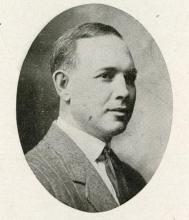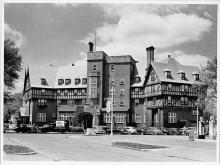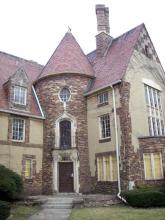Joseph William Royer
nformation on this page was provided by Dr. Brian Adams and can also be found in his book Joseph William Royer: Urbana's Architect.
 | Joseph William Royer was born in Urbana on August 2, 1873. He attended Urbana High School and graduated from the University of Illinois’ College of Engineering in 1895 with a degree in architecture. He was active as an architect for about 50 years, between 1897 and the early 1950s. During this period, he designed buildings not only in Champaign and Urbana, but throughout Illinois and into Iowa, Indiana, Wisconsin, and North Carolina. |
Royer worked as Urbana’s city engineer from 1898 to 1906. The firm of Royer and Brown was formed about 1905, and over the years was known as: Royer and Smith; Royer, Danely, and Smith; and Royer and Davis. To date, there are approximately 150 projects that can be attributed to Royer and his various firms. The available records and surviving buildings indicate schools and residences were the most common buildings designed by Royer, accounting for nearly half of his identified projects. These are followed by commercial and municipal projects, including several county courthouses built in Illinois, Iowa, Indiana, and Wisconsin. The remaining structures include fraternities, sororities, churches, hotels, county jails, libraries, theaters, country clubs, fraternal lodges, a post office, a pool complex, and a park shelter. | |
 | Surviving records indicate the earliest documented building designed by Royer was the Urbana residence for Stanley Boggs, built in 1897, and by 1898 Royer was designing commercial buildings. With the start of the 20th century, Joseph Royer was expanding his range of architectural designs. The new century started with the unveiling of Royer & Brown’s plans for the new Champaign County Courthouse. This Romanesque-style courthouse was ready of occupation by May of 1901, and was dedicated on August 22, 1901. |
Royer had a significant impact on the architectural legacy of Urbana. In addition to numerous private residences, he designed many building in the downtown area including the Flatiron Building (1906), the “old” Post Office (1906), the Illinois Theatre (1907), the Champaign County Poor Farm (1910), the 1st Cavalry Armory (1915), the Champaign County Sheriff Residence and Jail (1904), the Urbana Lincoln Hotel (1923), the Samuel T. Busey Memorial/Urbana Free Library (1917), the Knowlton-Bennett Drug Store (1926), and the First Christian Church (1909). On Wednesday, November 17, 1954 Joseph Royer suffered a heart attack and was taken to McKinley Hospital. Four days later, on Saturday, November 21, at 6:15 p.m. he died at age 81. | |
| Royer was a capable, prolific architect who was a master of traditional Queen Anne styles prevalent at the turn of the 19th century, as well as Academic and Historic Revival Styles. Surviving examples of Royer’s early residences from the late 19th century exhibit Late Victorian Queen Anne characteristics. At the beginning of the 20th century, Royer began designing buildings in styles that some have classified as “Academic Revivals”. Academic Revival styles included the American Classical Revival (1895-1950) and the Second Italian Renaissance Revival Urban Palace and Rural Villa styles (1890-1935). The American Classical Revival movement was fueled by the architecture of the 1893 World’s Columbian Exposition in Chicago, which employed classical Greek and Roman styles as models. Examples of structures designed by Royer in the Classical Revival Style include the Freeman Residence in Urbana and the Dewitt County Jailhouse in Clinton. The Winnebago County Courthouse exhibits characteristics of theSecond Italian Renaissance Revival Urban Palace style. Most of Royer’s subsequent works represent various revival styles popular during the late 19th and early 20th centuries, such as Romanesque Revival and Romantic Revivals (English, French, and Spanish). Surviving examples of Royer’s work indicate he began designing in the English Revival Styles beginning about 1910. These styles became especially popular after World War I. Many surviving examples of Royer’s buildings are done in variations of the English Revival styles, including the Urbana Lincoln Hotel (Tudor Revival), the Urbana Lincoln Lodge Hotel (Tudor Revival), the Champaign County Poor Farm (Jacobethan Revival), and numerous school buildings. Other revival styles represented by Royer’s work include Mission Style, Chateauesque Style, and Gothic Revival. Royer’s personal residence in Urbana is an example of the Mission Style, while the Alpha Rho Chi Fraternity house in Champaign and the Zeta Tau Alpha Sorority house were designed in the French Chateauesque Style. Urbana’s Universalist and First Presbyterian churches were executed in the gothic style. Though the bulk of Royer’s surviving work represents various types of revival styles outlined above, he also produced designs in more contemporary styles that were a reaction to the popular historical replicas of the time. These include the Christian Church in Urbana (Prairie Style), Effingham High School and Lincoln School, Dixon (Art Moderne/Art Deco), Leal School (Art Deco), Carle Medical and Maternity building (International Style) and the Mills-Petrie Memorial Library (Art Deco). |
| |

